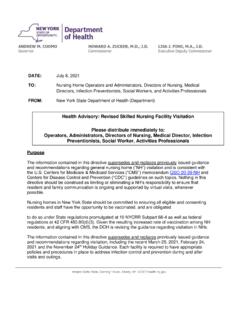Transcription of Essential Elements of a Reprocessing Program for Flexible ...
1 Essential Elements of a Reprocessing Program for Flexible Endoscopes Recommendations of the Healthcare Infection Control Practices Advisory Committee Preface The Healthcare Infection Control Practices Advisory Committee (HICPAC) is a federal advisory committee chartered to provide advice and guidance to the Centers for Disease Control and Prevention (CDC) and the Secretary of the Department of Health and Human Services (HHS) regarding the practice of infection control and strategies for surveillance, prevention, and control of healthcare-associated infections, antimicrobial resistance and related events in United States healthcare settings.
2 At the July 2015 HICPAC Meeting, CDC. asked HICPAC for guidance on ways to improve facility-level training and ensuring competency for Reprocessing endoscopes. To develop recommendations for HICPAC to consider, a HICPAC workgroup was formed that contained the following key stakeholder organizations: Accreditation Association for Ambulatory Health Care (AAAHC), Association for the Advancement of Medical Instrumentation (AAMI), American Gastroenterological Association (AGA), American Society for Gastrointestinal Endoscopy (ASGE), Association of periOperative Registered Nurses (AORN), Association for Professionals in Infection Control and Epidemiology (APIC), Centers for Medicare & Medicaid (CMS), Council of State and Territorial Epidemiologists (CSTE), DNVGL.
3 Healthcare, Food and Drug Administration (FDA), International Association of Healthcare Central Service Material Management (IAHCSMM), Public Health Agency of Canada (PHAC), Society of Gastroenterology Nurses and Associates (SGNA), Society for Healthcare Epidemiology of America (SHEA), and The Joint Commission (TJC). The Workgroup provided updates and obtained HICPAC input at the November 2015, March 2016, and July 2016 HICPAC Meetings. HICPAC voted to finalize the recommendations at the July 2016. meeting. Additional information about HICPAC is available on the HICPAC Website ( ).
4 Introduction Healthcare facilities should have a reliable, high-quality system for endoscope Reprocessing which minimizes infection risks. To achieve this goal, all Reprocessing programs must have an infrastructure that supports training and competencies, quality measurement, and management. The following guidance is provided to assist healthcare facilities, including clinical and administrative staff, to achieve a reliable, high-quality Reprocessing Program . A toolkit of sample documents accompanies this guidance to help facilities create and maintain the infrastructure to support their Flexible endoscope Reprocessing Program (available from: ).
5 Last update: January 25, 2017 Page 1 of 12. From: Essential Elements of a Reprocessing Program for Flexible Endoscopes Recommendations of the HICPAC. Recommendations Essential Steps for Flexible Endoscope Reprocessing To ensure Flexible endoscopes are safe for patient use, all staff involved in Reprocessing this equipment must understand and consistently follow a number of steps which have been distilled down to seven Essential steps. Ensuring adherence to these steps requires a complete and effective Reprocessing Program . These recommendations apply to all settings where endoscopic procedures are performed and where endoscopes are reprocessed.
6 1. Pre-cleaning a. Pre-clean Flexible endoscopes and reusable accessories by following the device manufacturer's instructions for use (IFU). Perform pre-cleaning immediately following completion of the endoscope procedure to help prevent the formation of biofilm. 2. Leak Testing a. For endoscopes that require leak testing, perform the leak test using manufacturer's IFU after each use and prior to manual cleaning. Leak testing detects damage to the external surfaces and internal channels of the endoscope that can lead to inadequate disinfection and further damage of the endoscope.
7 3. Manual Cleaning a. Perform meticulous manual cleaning including brushing and flushing channels and ports consistent with the manufacturer's IFU before performing high-level disinfection (HLD) or sterilization. Perform manual cleaning within the timeframe specified in the manufacturer's IFU. Manual cleaning is the most critical step in the disinfection process since residual organic material can reduce the effectiveness of HLD and sterilization. 4. Visual Inspection a. After manual cleaning, visually inspect the endoscope and its accessories. Visual inspection provides additional assurance that the endoscope and its accessories are clean and free of defects.
8 Complex devices such as Flexible endoscopes may require the use of lighted magnification or additional methods to assist with the inspection process. 5. Disinfection or Sterilization a. Following cleaning and visual inspection perform HLD or sterilization in accordance with the manufacturer's IFU. Carefully review and adhere to the endoscope manufacturer's Reprocessing instructions and to the IFU for chemicals or sterilants and any equipment ( , automated endoscope reprocessors) used for Reprocessing to help ensure that effective disinfection occurs.
9 6. Storage a. After Reprocessing is complete, store endoscopes and accessories in a manner that prevents recontamination, protects the equipment from damage, and promotes drying. Store processed Flexible endoscopes in a cabinet that is either: 1. of sufficient height, width, and depth to allow Flexible endoscopes to hang vertically without coiling and without touching the bottom of the cabinet OR. Last update: June 28, 2017 Page 2 of 12. Essential Elements of a Reprocessing Program for Flexible Endoscopes Recommendations of the HICPAC. 2. designed and intended by the manufacturer for horizontal storage of Flexible endoscopes 7.
10 Documentation a. Maintain documentation of adherence to these Essential steps each time an endoscope is reprocessed. Documentation is Essential for quality assurance purposes and for patient tracing in the event a look back is necessary. Essential Elements of a Reprocessing Program for Flexible Endoscopes Administrative 1. Leadership of the healthcare organization or practice setting where Flexible endoscopes are used and/or reprocessed is accountable for: a. Allocating sufficient human and material resources to ensure that the selection, use, and Reprocessing of endoscopes and related accessories are managed in a manner that minimizes infection risk and supports patient and healthcare worker safety.










